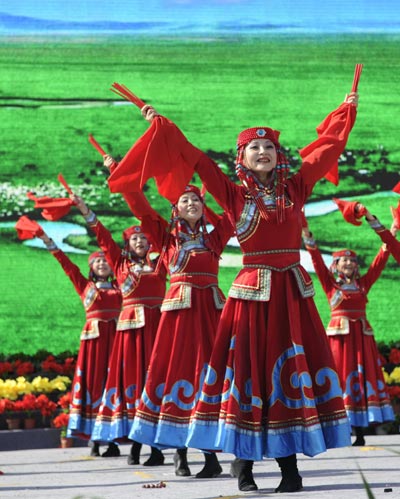Mongolian swan songs
 0 Comment(s)
0 Comment(s) Print
Print E-mail China Daily, November 15, 2013
E-mail China Daily, November 15, 2013
|
Singing has been an indelible part of life for Mongolian people who always have music on their lips and in their hearts. [Photo/Xinhua] |
Battogoo, 50, runs a workshop making silverware. Although he recalls seeing silverware everywhere when he was a child, he realized that it was disappearing from the market.
He became determined to revive the craft around 2006, when the government sent out a call to revitalize the industry.
Battogoo had learned silver-craft when he was younger, and it was easy for him to pick it up again.
He knows things will never be the same. Part of the old processes has been replaced by modern tools. While he appreciated the convenience, he also regretted the passing of traditional handwork.
He has two apprentices, and together they run the three silverware workshops in the banner seat. Museum curator Liu estimates that the total number of silversmiths in the banner to be only around 10.
Urad silverware was listed as Inner Mongolia's intangible cultural heritage in 2011.
"There's no need to compare our Urad silverware with those in the southern provinces. They are all recordings of local folklores from their respective cultures. Urad silverware represents the nomadic civilization, and is closer to localized aesthetic standards," Liu says.
Battogoo does not display his work in showcases. Instead he only makes to order. A whole set of silver wedding hair accessories may weigh as much as 1.8kg and cost about 40,000 yuan ($6,600). It will also take the full commitment of two silversmiths, who may use up to two months to create the jewelry.
Curator Liu says his museum has opened up a 700-square-meter hall to exhibit Urad intangible cultural heritage items, but confesses that it did not attract enough attention locally.
"Nearly 20,000 people visited the hall last year, but the vast majority were tourists. If we are not able to get the local people interested in the heritage, we will find it more difficult to protect it."
To encourage better appreciation and understanding, Liu says, the banner will establish an intangible cultural heritage protection association in the near future to offer all item inheritors a better platform to display their talents.
This is a common problem for those who try to protect Bayannur cultural heritage.
"Many people have the wrong idea that intangible cultural heritage means songs and dances," says Liu Fei, head of Bayannur municipal office in charge of cultural protection. It is a lot more, he adds.
"Protection of these items needs much behind-the-scenes work, including compiling historic archives, and establishing a database. We need money to carry this out."
Bayannur gets 200,000 yuan every year from the local government for intangible cultural heritage-related work, but Liu Fei says it is not enough.
"Everyone here works for the love of the culture. We struggle to apply for more financial support, but that's all we can do," Liu Fei says.
More visible items like the Urad ballads and silver-craft are being revitalized, but the lesser-known glass and brick paintings are inevitably disappearing.
"The ancient Urad tribe never lacks for cultural treasures, but without professional help in collating relevant data needed for the bid for intangible cultural heritage status, they will soon be lost."







Go to Forum >>0 Comment(s)